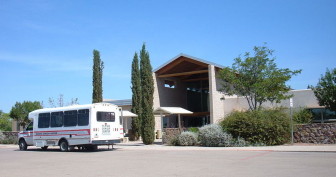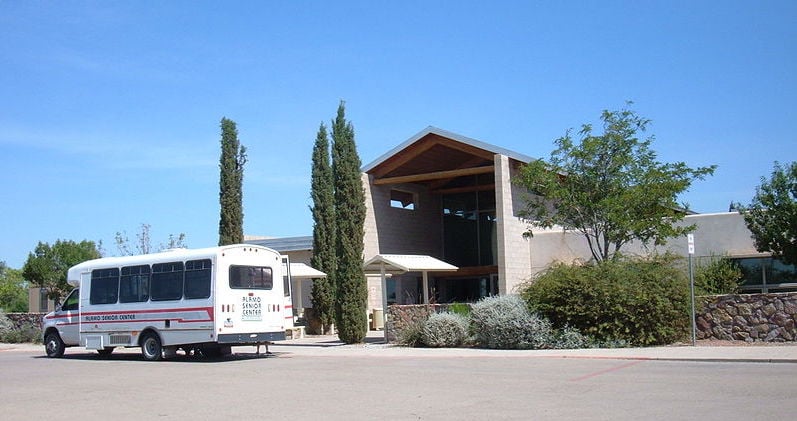
Wiki Commons
Up to $11 million in funding for aging programs was lost when lawmakers failed to agree on a capital budget plan.
Back-room debates. Angry lawmakers. A meltdown that doomed up to $297 million to pay for brick-and-mortar projects and roads across New Mexico.
The high-stakes political game of the just-ended legislative session over capital outlay might raise hopes among critics that their lonely chorus calling for reform might grow larger.
But don’t count on it, some legislators say. These officials wonder whether even this year’s dramatic demise of the capital outlay bill could generate enough political will to reform a process that encourages individual legislators, the governor and the executive branch to fund pet projects.
It’s a system that’s been around for years and is a perk of holding public office. Bringing home money for senior centers, school playgrounds or high-profile building renovations allows politicians to point to tangible proof of what they’re doing for their constituents. It also can help them come re-election time.
“Governors and legislators, they all want to go home and say this is what I brought you in pork barrel,” said Democratic Sen. John Arthur Smith of Deming, who is the powerful chairman of the Senate Finance Committee. “It’s a pretty poor process.”
Before the session began, New Mexico In Depth examined the capital outlay process for a legislative guide, including producing a searchable list of projects funding in 2014.
What it found was that New Mexico’s system for selecting and paying for such projects is unusual. One academic who studies the issue put New Mexico in context, saying New Mexico’s process appears to stand alone among U.S. states as a form of “pork barrel” politics.
New Mexico’s system defies easy description. In fact, in recent years it appears to have changed from year to year, longtime observers say.
One thing is clear: The final decision of what gets funded happens during each year’s legislative session, with a deal reached following behind-the-scenes negotiations and a willingness by all parties to communicate and compromise.
That didn’t happen this year. The result was a cloud of partisan bickering and finger-pointing, but no solution how to avoid such last-minute blowups in the future.
The meltdown
Months before the end-of-session meltdown, New Mexico’s capital outlay process began quietly, as it does every year.
The Department of Finance and Administration requires state agencies to make and prioritize their requests for capital money in five-year plans. The Legislative Finance Committee, the Legislature’s budget arm, is updated on such projects by legislative and executive staff.
Meanwhile, throughout the year Legislative Finance Committee staff travels the state screening projects to ensure long-term planning goes into how the state parcels out money for brick-and-mortar projects, Smith said.
Those preparations lead to the annual legislative session.
That’s where a framework bill is assembled with high-priority state projects. Legislative leaders from both parties begin meeting, often with representatives from the executive branch, to talk about the bill.
Those meetings began in mid-February this year, more than a month before the session’s scheduled March 21 end date, according to a timeline put together by legislative staff.
Running almost parallel with those talks was this year’s sacrificial lamb of a reform bill. While many legislators appear to like the current system, a few critics have sought to change the system and 2015 was no different.
That bill died in the Senate Public Affairs Committee on March 3 as Republicans and Democrats rejected a bill to reform the capital outlay process.
Here things begin to get hazy as to how the capital outlay talks devolved into partisan rancor and acrimony at the end of the session, which speaks to the lack of openness in the process.
A little more than a week after the reform bill died, Republican House leaders walked out of a meeting on a bill to fund capital projects, said Sen. Carlos Cisneros, D-Questa. Cisneros sponsored the bill in the Senate.
“That set the stage for the demise of the bill,” the Democrat said.
House Ways and Means Chairman Jason Harper, R-Rio Rancho, said that isn’t what he recalls.
“We had around four to six meetings. I don’t remember us ever standing up and just leaving in the middle of the meeting,” he said. “Every meeting was pretty much the same. We started off with a different proposal and we talked about it. It always came back to money for roads.”
On March 17, the Senate voted unanimously to approve this year’s capital outlay bill.
Three days later, on the next to last day of the session, House Republicans dramatically amended the bill in committee, deleting projects for higher education, senior centers and tribal communities. Those projects were replaced by others.
The amendment from the House Republicans, who are in control of that chamber for the first time in 60 years, was generally viewed as reflecting the priorities of Republican Gov. Susana Martinez.
The amendment sparked a political standoff in the last 24 hours of the session, a time when lawmakers already are tired, nerves are frayed and patience sometimes is in short supply.
Here’s a look at the broad differences between the two bills:
One sticking point was how the Republican amendment proposed paying for some of the projects.
The House Republicans proposed using severance tax bonds — think of it as the state’s credit card — to pay for $45 million for roads rather than using the state’s main checking account, known as the general fund, as the Senate wanted to do.
Rep. Tim Lewis, R-Rio Rancho, who sponsored the capital outlay bill in the House, said the Senate knew the governor wanted $45 million for roads to come out of severance taxes, but instead took the money from the general fund. Smith and some other Democratic senators originally wanted a gas tax increase, a measure which never had a committee hearing.
“It’s never been done before where the Senate, one group, told the governor how to spend her money,” Lewis said.
Here’s a look at key differences for different service areas in the two versions:
The governor never submitted her own capital budget before the House Republican amendment, several senators said. Martinez’s spokesman did not return a voicemail and email requesting information for this story.
“She never gave a list of the statewide projects that she had prioritized because the Senate just went off on their own,” Harper said. “I don’t see that as a big issue.”
The full House took up the bill on the morning of March 21 with less than four hours to go before the session ended. A Democratic attempt to restore the Senate version failed on a party-line vote, then the bill passed the House on a party-line vote.
By that time only about 20 minutes remained until the noon deadline for the Legislature to adjourn, and the capital outlay bill never made it to the Senate floor for a vote.
It died.
“It wasn’t about elderly, it wasn’t about courts, it wasn’t about higher ed at all,” Lewis said. “If it was about those things, they wouldn’t have killed the final bill. They threw the baby out with the bathwater. They said ‘We get what we want or nobody gets anything.’ ”
Several senators, including Smith, accused the governor and House Republicans of the same type of behavior.
If everyone is to be believed, no one budged in the last 24 hours of the session
“That kind of disagreement is not without precedent,” said state Auditor Tim Keller, a former state senator who recalled the capital bill failing in 2011. “It probably is equally political and structural process.”
Cisneros attributed part of the failure to House Republicans’ inexperience after being out of leadership for 60 years.
“To shift the rotation of the Earth on their first time out as the majority, that was not going to happen either,” Cisneros said. “It’s just too much too soon.”
Reform efforts
Cisneros said he plans to introduce a bill next session to change New Mexico’s process for funding brick-and-mortar projects.
He doesn’t have an issue with each lawmaker allocating a specific amount to their projects.
Both the Senate and House versions of the failed capital outlay bill included $1 million for each of the 42 senators and $600,000 for each of the 70 representatives to allocate. Cisneros said lawmakers know local needs better than state-level analysts.
But he’d like to see a requirement that projects be fully funded over a lawmaker’s two- or four-year term to be included in the process, he said.
“Where we have a problem is that traditionally New Mexico’s Legislature has provided funding, but not enough to complete a project,” he said.
Keller too would like to see a requirement that money be spent within a certain amount of time as well as improvements in how projects are prioritized.
He also suggested a provision that would re-direct unspent money to other needs if a project isn’t underway within a certain number of years.
About $4.5 billion in state money is unspent, Keller’s office reported earlier this month. That includes $1.2 billion in unspent capital outlay money.
“There’s lots of things we could do to improve the process,” he said. “I’m optimistic because each year the problem seems to get worse. So eventually we know we’re going to have to do something about it.”
New Mexico’s officials could turn to some of its neighbors for ideas.
In Utah, which some hold up as a model, a board appointed by the governor holds hearings and prioritizes projects, sending a list to the governor. The governor’s office uses that list to create its own priorities and both lists are sent to the legislature.
Oklahoma, meanwhile, has a planning commission with citizens appointed by the governor, the state House and the state Senate that prioritizes capital projects. The commission submits the list to the legislature, which has 45 days to remove projects from the list. None can be added, however.
Next steps
Lewis said improvements have been made to the capital outlay process over the years. In the 1990s, for instance, some lawmakers received far more money for their districts than others. Now there are equal shares.
This governor also has begun requiring local governments to have audits in order to receive money, and has focused on fully funding projects, Lewis said.
“I think it’s come a long way,” he said. “It is more fair than it used to be.”
But Harper is a critic of the pork barrel.
“We’re the only state that does it this way, where individual legislators get a certain amount of dollars to bring home to their district,” he said. “I really think we should consider going to something that’s similar to our public school capital outlay.”
An appointed, nonpartisan Public School Capital Outlay Council decides what public school construction and renovation projects should be funded by the state.
But the state’s politicians didn’t push for that reform, said Smith, the Senate Finance Committee chairman. The council, which funds school projects around the state, came about in part as a reaction to a 1998 lawsuit filed in state district court by the Zuni Public Schools and later joined by the Gallup-McKinley County Public Schools and the Grants-Cibola County Public Schools, according to a legislative memo.
“This is kind of a good time to look at other ways to do this process,” Harper said.
Lewis said he would be shocked if Gov. Martinez called a special session to revisit capital outlay funding this year, noting that the legislature approved the two things that were must-dos: a budget and a new gaming compact with Indian tribes.
Lewis questioned whether allocating New Mexico’s building money can ever satisfy everyone.
“There’s a certain element of politics in everything,” he said.
